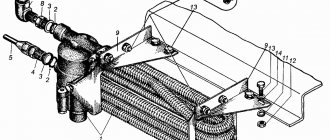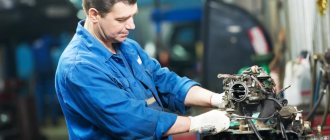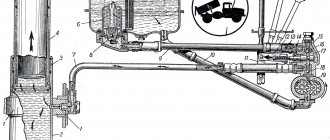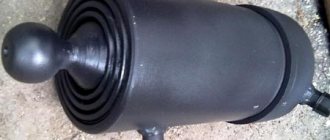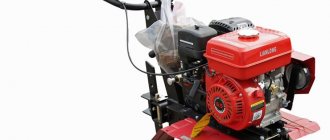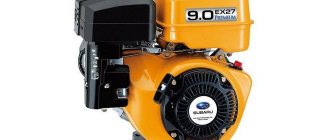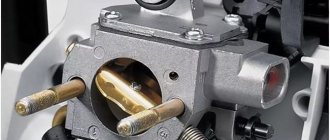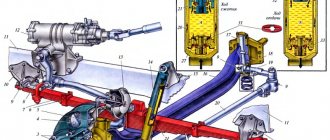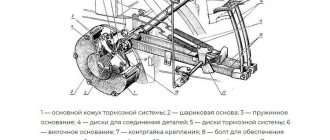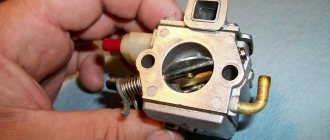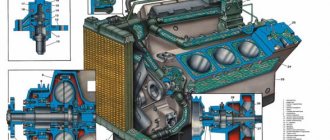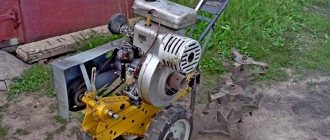The most common “sore” is wear of the balancer bushings! The second problem is the wear of the cheeks under the spring. The permissible gap between the axle and the balancer bushings according to the manufacturer's passport is 1 mm. In fact, with such a gap, enormous loads are placed on the bushing, especially during turns.
There are 4 types of bushings made of different materials: bronze bushings, aluminum with zinc, just aluminum and plastic! We use alloy bushings: aluminum with zinc, bronze, I’ll tell you why! If the balancer axis is in normal condition, that is, its cylindrical wear is 0.1 - 0.2 mm, then you can safely use zinc bushings, they are quite strong and one and a half times cheaper than bronze ones, but they are quite fragile; shoulder". If the axle is worn more than 0.2 mm, it is advisable to use bronze bushings, since bronze is more viscous than zinc and can withstand heavy loads, especially, I repeat, when turning! We don’t use aluminum and plastic bushings for the reason that with today’s overloaded machines, they simply cannot withstand the loads and after 2 years of operation they simply break, at least on grain trucks.
Clearances and boring of bushings
Now let's talk about clearances and bushing boring. Initially, you need to choose the right bushings according to its dimensions, namely the outer and inner diameters. In order for the bushing to be tightly pressed into the balancer, its outer diameter must be 100.2 - 100.3 mm; on bronze bushings up to 100.5 mm is permissible. The inner diameter of the bushing must be 0.5 - 1 mm less than the nominal value in order to accurately bore the balancer with bushings in one installation. Boring the bushings first in a lathe and subsequent pressing will not give the desired result, since the balancer itself often has an elliptical and conical seat, the bushing also has an allowance of 0.2 - 0.3 mm on the outer diameter, so after pressing the bushings on both sides, the alignment between them will not be ideal, the internal size of the bushing will repeat all the errors of the balancer, and as a result it is almost impossible to adjust the axle diameter in this way. Therefore, we press the bushings into the balancer, install them on a boring machine and bore 2 bushings at once from one installation. The bored diameter of the bushings should be 0.05 - 0.08 mm larger than the axis of the balancer. The diameter of the standard axle is 88, then the diameter of the seat in the balancer is 88.05 - 88.08. The smaller the gap between the axle and the bushings, the longer it will take until it wears to a critical size. With every tenth mm. When the bushing wears out, the wear rate increases significantly, since the gap allows the balancer to swing in different planes, thus wearing out the axle and the bushings themselves. Therefore, our experience in repairing the balancer allows us to say that the maximum gap before replacing the balancer bushings should be no more than 0.5 mm.
About wear of the balancer axis
Now let's touch on the wear of the balancer axis itself. The technological process for manufacturing balancer axes is quite complex and can only be carried out in a factory setting. What is the difficulty? This is not only turning, grinding the ends for the shoes, pressing into brackets, but most importantly, it is the heat treatment of the places for the bushings. Ideally, as was the case in Soviet times, the area for the bushings was carburized, hardened and ground. The hardness of the bushing places is 62 - 64 HRs according to Rockwell, this is the hardness of a file. The balancer bushing is a softer material, so it is a replaceable part. Since in the old-style shoes the bushings were lubricated with a “tap” poured into the shoe itself, excellent sliding was ensured; the hardness of the axle prevented the material of the bushing from sticking to it. If the shoe bushings were changed in time and lubrication was not lost, the axle could last up to 30 years, with minimal wear of up to 0.2 mm. In today's conditions, without quality control and loss of production culture, the quality of spare parts does not stand up to criticism, so it is not surprising that modern balancer axles are not heat treated at all. on new KAMAZ trucks that are 2 years old, the wear of the axle (where there are plastic bushings in the shoes) was up to 1 mm. Lubrication in these shoes is provided only through grease fittings; there are no oil seals. Therefore, when moisture gets into the shoe and it is not pumped in a timely manner, dirt and rust accumulate inside the bushings, which works like sandpaper, wearing out the axle. Moreover, when our cars are overloaded, especially grain trucks, which are loaded like railway cars, the plastic bushings are simply interrupted by the axle, reaching the body of the shoe. What can be advised when the axle wears out? The balancer axis is developed mainly from below and barrel-shaped, but that part of the axle where there is no contact with the bushings does not wear out, this is a gap of 20 mm where the bushings in the shoe have a distance between them. Therefore, even if the axle is worn out, the size of the shoe bushings when replacing must be standard (88.05 mm), otherwise it simply will not sit in its place.
Repair
During the operation of KamAZ, the balancer, despite the strength of the parts, wears out, which leads to breakdown of its components. Therefore, inspection and maintenance are carried out in a timely manner in specialized service centers or with your own hands.
Rear suspension repair involves diagnosing and replacing brackets and bushings due to emerging defects, such as:
At the same time, the condition of springs, reactive traction loads, stepladders, oil seals and shoes is checked.
Bushing wear is a common cause of balancer failure. The fit of the parts is periodically checked by tapping with a hammer. When loosened, the pins are replaced with new ones. Bushings are repaired when consumables wear up to 90.2 mm.
If there is an oil leak from the crankcase, replace the seals.
Repairing the balancer axis consists of eliminating traces of damage by grinding and installing repair elements reduced in internal dimensions.
How to adjust
Adjusting the axial clearance in the balancer shoe on a KamAZ vehicle is performed as follows:
- Place the machine on a stand.
- Pull the spring ends from the rear axle supports and remove the part, thereby ensuring the rotation of the balancer.
- Unscrew the split nut so that the mechanism cannot be turned by hand.
- Unscrew it 1/6 turn.
- Tighten the pinch bolt. The tightening torque should be 8-10 kgf*m.
- Check the rotation of the balancer. If they are difficult, loosen the pinch bolt and unscrew the nut.
Replacing bushings
As you drive, the wear rate increases. An increase in the space between the bushing and the axle affects the balancer, which swings in different planes and deforms the parts.
The standard axle diameter is 88 mm. For tight pressing, the outer dimensions of the balancer bushing are 100.2-100.3 mm, the inner dimensions are 1 mm less.
The nominal gap is 0.12-0.30 mm. Replacement of worn bushings is carried out when the critical value reaches 1 mm.
The balancer at the landing site can be ellipsoidal or conical. For alignment and reliability, it is better to press the bushings into the shoe, install them on a boring machine and bore 2 pieces at once. The calculated diameter of the sleeve should be 0.05-0.08 mm larger.
Maintenance
It is better to carry out maintenance at specialized repair stations. With timely replacement of parts and repair of the balancer, its service life can reach up to 10 years. Instructions for carrying out maintenance of this Kamaz part are presented on the official website of the manufacturer.
When undergoing maintenance you must:
- check the balancer broaches;
- check the tightness of the fastening;
- make sure that the balancer bushings can be used further and do not require replacement;
- check for oil and grease in the devices;
- check the wear percentage of the bushings and spring.
Kamaz balancer lubrication
Lubricant is used in balancers to treat open areas of the device that are protected by anthers. Oil should be poured into sealed units in small quantities. The service station where the car undergoes maintenance will advise you which oil to choose.
Do-it-yourself KAMAZ balancer repair
When repairing a KAMAZ balancer axle or repairing a KAMAZ balancer shoe, it should be taken into account that this axle has a nominal size of 8.8 cm, the shoe bushing is 8.75 cm, and the repair bushing is approximately 8.4 cm. The nominal size of the gap between the bushings and axle - from 0.12 to 0.305 mm, and the permissible maximum gap size between the bushings and the axle is 1 mm. If the bushings move freely, they must be replaced with new ones. We also need to replace the balancer cuff, boot, protective cup and nut, and inject the shoes using a grease fitting.
If cracks are detected in the spring sheets, they must be replaced with main sheets with a thickness of 12 mm (nominal) to 18 mm (maximum). It is recommended to measure the sheet size using a tape measure and caliper to provide the seller with accurate data. When assembling the springs, it is necessary to lubricate the rubbing leaf surfaces with graphite-based lubricant, and lubricate the pins on the front springs. Installation of rear and front springs on a car is carried out in pairs, the difference in deflection should not exceed 1 cm.
KAMAZ balancer axle diagram
Procedure for adjusting the axial clearance of the balancer shoe
- Lift the car by the frame, place it on stands, make it possible to rotate the balancer by separating the ends of the spring located at the rear from the bridge supports, or by removing the spring.
- Screwing the split nut in such a way as to prevent the balancer from turning by hand.
- Unscrewing the nut one-sixth of a turn, tightening the pinch bolt and checking that the balancer can be turned manually; If it is impossible to turn it, you should additionally loosen the split nut, loosening the tie bolt in advance.
In case of replacement, stepladders also need to be measured. During this process, the thread, its pitch, the width of the landing site, as well as the length of the stepladder at this site are measured. When inspecting the reaction rods, you need to take a closer look at the fit of the fingers in the bracket - if free movement of the fingers is detected, they need to be replaced. The seat has a nominal size of 43 mm. In case of higher output, it makes sense to try the fingers from the KRAZ machine. The fingers are syringed using a grease fitting.
Kamaz rear suspension
The rear suspension of three-axle cars is balanced on two springs.
With this suspension, the intermediate and rear axles swing relative to the balancer axis
In this case, the springs perceive only the force of gravity of the car; other forces and moments are transmitted by pushers and reaction rods.
The balance suspension of the intermediate and rear axles of the KamAZ-5320 vehicle is shown in Fig. 1
The rods pivotally connecting the axles to the frame form a lever suspension in the form of a parallelogram
On the brackets attached to the frame side members, the balancing device brackets into which the axle is pressed are secured with studs and nuts.
The shoe can be rotated on an axis in two bronze bushings, held from axial displacement by a split nut tightened with a bolt.
The middle of an inverted semi-elliptical spring is attached to the shoe with stepladders and a pad.
The ends of the springs are installed on supports.
When the springs bend, their ends slide in the supports.
When the axles move downwards, the springs are held in the supports by fingers.
Pushing forces and reaction moments are transmitted to the frame by six reaction rods. The reaction rod hinges are self-clamping.
The ball pins of the hinges are located between the spherical liners 5 and 7. To seal the hinge from leakage of lubricant and dirt, an end seal 8 is installed
Based on the distance between the centers of the tip holes, reaction rods are divided into four selective groups. The rods of adjacent groups may differ in length by 0.6...1.2 mm.
The lower suspension rods have one group, since with an unfavorable combination of sizes, it is possible to install the intermediate and rear axles at an angle to each other, which increases fuel consumption and causes increased tire wear.
The installation of upper suspension rods by group is not regulated. The group marking is marked on the head of the rod end and is covered by the hinge seal.
The suspension distributes loads evenly between the intermediate and rear axles, and they can move up and down independently of each other as a result of the rotation of the shoe.
The possibility of relative angular transverse misalignment of bridges when a vehicle moves on an uneven road is due to the sliding of the ends of the springs in the supports.
The rear suspension of KamAZ-53212, -54112, -5511 vehicles, unlike other vehicles, has a balancing device with one axis (Fig. 4), which also serves as a balancer tie.
The springs of this suspension are reinforced and consist of 14 leaves instead of 9.
The first, second, third and last sheets of this spring are rectangular in section, the remaining sheets are T-shaped.
To fasten the spring to the shoe, reinforced stepladders 2 are used.
On KamAZ-4310 vehicles, the rear spring step nuts are secured against self-loosening with locknuts.
Replacing balancer bushings
The KAMAZ 6520 balancer shoe bushing (dimensions: W 24 cm, H 15 cm, D 24 cm, weight 1.12 kg) is a cylindrical or cone-shaped spare part that has axial symmetry and a hole. The element absorbs mechanical load (shocks, vibrations), allowing the suspension to operate with maximum efficiency.
This part is also suitable for KAMAZ 6522, 6460. Bushings for other KamAZ models are approximately similar in design, the only difference is in size.
When the middle and rear axles operate, the spare part experiences enormous loads, which is why it is so important that the bushings are always in good condition. Wear of elements is assessed during maintenance, which should be carried out regularly, especially during active use of special equipment. Replacement is required if the distance between the bushing and the axle is more than 1 mm.
KAMAZ balancer repair kit complete P1 102x86.5 (34 units) KAMAZ balancer bushing P0 100x88 (BRONZE)
Boring of bushings
The dimensions of the new spare part are smaller than the diameter of the axle; to accurately match the dimensions, the parts are turned on lathe equipment.
Important! When installing, the maximum distance between the bushing and the axle should be no more than 0.5 mm. As the clearance between components decreases, the bushing's resistance to wear increases. So, one tenth of a millimeter increases wear significantly, because the larger the gap, the easier it is for the balancer to swing in different directions, which wears out the axle and bushings. This is especially true for the plastic bushings of the KamAZ balancer, which are more susceptible to wear than others.
There are other features of the procedure:
- Boring is carried out after installing the element in the balancing shoe. The linear dimensions of the components eliminate any shortcomings during pressing, that is, the bushing is always securely fixed inside the shoe.
- Then boring is carried out to the required size, taking into account errors.
- When boring a pressed part, its diameter must be 0.05 - 0.08 mm greater than the value of the balancer.
- Before attaching the shoes to the axle, the bushings are lubricated with a special compound.
After installing the bushings, the equipment is ready for operation as before, with periodic technical inspections to assess wear.
By the way! It is impossible to bore the part in advance (before pressing it in), since then the bushing on both sides will not have the required alignment, and the internal parts will repeat the shortcomings of the balancer. That is, it will be almost impossible to combine two elements in size.
From us you can purchase not only KamAZ balancer bushings, but also KamAZ king pin bushings, which are used on the front axle of the vehicle.
KAMAZ EURO king pin bushing spacer (BLACK) KAMAZ EURO-2 king pin bushing spacer (GO)
Wear of the balancer axis
We should also touch on the topic of wear on the balancer axis. The technological procedure for manufacturing the balancer axes is quite complex and can only be carried out in a factory environment. The difficulty lies in the fact that this is not just turning, machining the ends for the shoes and pressing into the brackets, but also heat treating the areas for the bushings.
The ideal situation was in Soviet times, when the places for the bushings were hardened, cemented and ground. The spaces for the bushings have a Rockwell hardness of 62-64 HRc, which is equal to the hardness of a file. The balancer bushing is a softer material and is a replaceable element. Due to the fact that in old shoes the bushings were lubricated with “thaw”, which was poured inside, good sliding was ensured; the hardness of the axles did not allow the material of the bushing to be riveted onto it.
With timely replacement of the shoe bushing and no lubrication, the axle could last up to 30 years, with less wear (up to 0.2 millimeters). In modern conditions, without loss of production culture and without quality control, the reliability of spare parts cannot withstand criticism, so it is not surprising that balancer axles are not thermally treated on new trucks, on which axle wear is up to 1 millimeter in 2 years.
Wear of the cheeks under the spring
Wear of balancer bushings is the most common “disease”. The second problem is the wear of the cheeks under the spring. A gap is allowed between the bushings and the balancer axis (according to the manufacturer’s passport - about 1 millimeter). With such a gap, in fact, large loads are applied to the bushing, especially during turns.
There are four types of bushings made of different materials: aluminum with zinc, bronze bushings, regular plastic and aluminum. Our company most often uses bushings made of bronze and aluminum-zinc alloy.
The fact is that the balancer axis is in normal condition, i.e. in terms of cylindricity, its wear is 0.1-0.2 millimeters; in this case, bushings with zinc are ideal, which are quite strong and one and a half times cheaper than bronze ones, but they are quite fragile (the “shoulder” breaks off on them on worn axles).
When the axle is worn by more than 0.2 millimeters, it is recommended to use bronze bushings when overhauling a KAMAZ, because bronze is more viscous than zinc and can withstand heavy loads, especially when turning. Plastic and aluminum bushings are not used, because the parts cannot withstand the loads and after two years of operation they break.
We should talk about bushing boring and clearances. First of all, it is necessary to select the correct bushings by size, or rather, by internal and external diameters.
To tightly press the bushing into the balancer, it must have an outer diameter of 100.2-100.3 millimeters; on bronze bushings, a size of up to 100.5 millimeters is allowed. The bushing must have an internal diameter 0.5-1 millimeter less than the nominal value for high-quality boring of the balancer with bushings.
